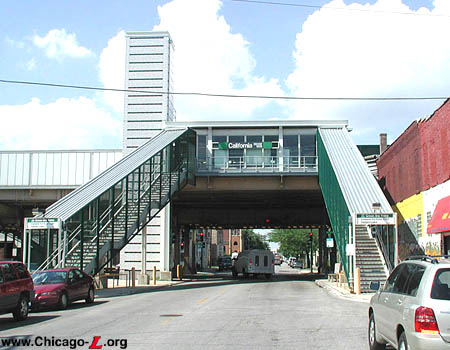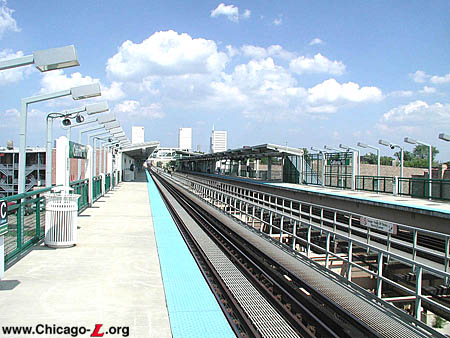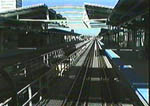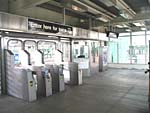|
History:
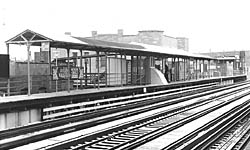
The station house
removed after being damaged in a fire three years
earlier, the inbound platform at California still
has its 1890s canopies but fare controls are behind
a plexiglas wall where the headhouse once stood,
looking west on December 11, 1980.
(Photo from the Chicago
Transit Authority Collection)
|
California station opened as the western temporary terminal
when the Lake Street Elevated first began regular passenger
service at 5 am on November 6, 1893. As more stations were
completed, service was extended west. Designed by the
Railroad's engineering staff, the station was an iron
structure that represented a unique attempt to apply the
Queen Anne architectural style, more typical of wood or
brick houses, to a elevated metal transit station. The
station houses also presented strong influences from the
High Victorian Gothic style, although the stations'
construction in 1892 represented a late application of this
style. The exteriors were clad in corrugated metal siding
with decorative detail in the metal and wood trim around the
windows and in panels below. Perhaps the stations' most
identifiable features were the buildings' characteristic
"pagoda"-like cupolas.
Because the fare controls were at track level, this
required two separate station houses per station: one per
direction, connected to each platform. The interiors of
these stations had floor to ceiling tongue-in-groove
paneling and wood moldings, with a wood floor, peaked
ceiling, circular windows on the walls at the peaks, benches
along the walls, and wood-burning stoves in the center of
the room to heat the station. The ticket offices in the Lake
Street stations were on the trackside walls of the interior.
The platforms had short canopies, covering just a few cars,
which were actually extensions of the station house
roofs.
By the
1970s, the station was suffering from deterioration,
resulting in vandalism and misuse. In July 1977, the
eastbound station house fell victim to a fire and was
subsequently removed. It was replaced simply by Plexiglas
enclosures and partitions and a wooden agent's booth on the
platform. By 1980, the westbound station house was gone as
well and replaced with a treatment similar to the eastbound
side. The station retained a few of its original features,
like its ornate canopies, but was otherwise of a simple,
utilitarian design.
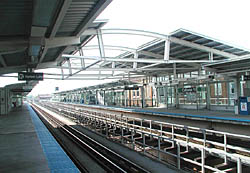
The California
platform, with its unusual full-width
center-section canopy design, looking west on July
15, 2003. For a larger view, click here.
(Photo by Graham Garfield)
|
California was closed in the service revision of February
9, 1992, chosen along with several other stations and
auxiliary entrances because of its low ridership and
availability of alternate transit options, to help balance
the CTA's budget.
Ironically, only a few years after closing as a result of
low ridership, California was resurrected during the Green
Line rehabilitation of 1994-96. There was intense political
pressure to retain stops and this situation had the unusual
result of the decision to replace a station that had been
closed for poor performance and cost-recovery a few years
before with an all-new facility. California's brand new
design was developed by Skidmore, Owings & Merrill
(SOM), who had been selected in 1993 as a lead
architecture/engineering firm for the renovation of the
stations along the Green Line. The new station was executed,
at a basic level, following the "open plan" design. The new
station house, located at track level, is constructed of
white steel, large glass windows and green accents. Unlike
the previous incarnations of the station, only one fare
control area was provided for the both directions, located
at track-level on the south (inbound) side. An elevator on
the southwest corner of Lake and California, decorated in
white tile with green stripes, stands ready to bring
passengers to the station house. To access the outbound
platform on the north side, riders must utilize another set
of elevators east of the station house, connected over the
tracks by an elevated bridge. The canopy extends the entire
width of the platforms, but unlike the horizontally flat
canopies of many new "L" stations of the preceding decades,
this one has a peaked roof with postmodern, unusual angled
latticework in the center section.
Because of construction delays, the new California
station did not open when Green Line service resumed on May
12, 1996. Although the stop did open, it was operated with
temporary facilities until the main fare control area was
completed. The platforms were largely done in May, but the
ticket agents were located in temporary wooden booths at the
auxiliary exit stairs at Mozart Avenue, a block east of
California. The station was officially dedicated on July 13,
1996 and the new station house and elevators came into use
on August 5. At that time, the Mozart fare controls were
removed and those stairs became auxiliary exit-only, as
intended.
|
